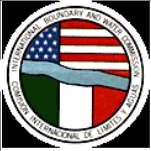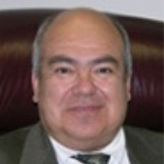The International Boundary and Water Commission, United States and Mexico (IBWC) is a bilateral government body charged with maintaining border and water agreements along the international border between the United States and Mexico. The commission’s American section (USIBWC) is overseen by the State Department, and its origin dates back to the 19th century. The USIBWC’s structure and many functions are defined by treaties signed during the first half of the 20th century.
- The South Bay International Wastewater Treatment Plant is a 25 million gallon per day advanced primary treatment plant located in San Diego County, CA, about 2 miles west of the San Ysidro Port of Entry. The plant treats sewage originating in Tijuana, Mexico and discharges it to the Pacific Ocean through the South Bay Ocean Outfall, a four and one-half mile pipe.
- The Nogales International Wastewater Treatment Plant in Arizona is near the Santa Cruz River/Nogales Wash confluence, about ten miles north of Ambos, Nogales. It treats a daily average dry weather flow of approximately fourteen million gallons, of which 70% is from Mexico. Its outdated technology is expected to be replaced through a $60 million upgrade by 2009.
- The Nuevo Laredo Wastewater Treatment Plant treats sewage from Nuevo Laredo according to standards agreed to by the IBWC.
The commission is involved with helping to enforce the Texas Clean Rivers program. In 1991, the Texas Legislature passed the Texas Clean Rivers Act in response to growing concerns about water pollution. Because of the international nature of the Rio Grande, the state of Texas contracted with the USIBWC in October 1998 to implement the Clean Rivers Program for the Rio Grande along its 1,254-mile international boundary section.
- Table of Contents
- Overview
- History
- What it Does
- Where Does the Money Go
- Controversies
- Suggested Reforms
- Comments
- Leave a comment



Carlos Marin served from December 2006 as the United States Commissioner of the International Boundary and Water Commission, United States and Mexico. Marin received his Bachelor's Degree in Civil Engineering from the University of Texas at El Paso in 1978. He began his career at the US Bureau of Reclamation where he worked from 1975 to 1979 at offices in El Paso, TX; Denver, CO, and Las Vegas, NV as a civil engineer trainee and as an engineer working on projects such as the Upper Rio Grande Water Conveyance Project and the Pittman Lateral and pump station.
- Latest News
- D.C. Public Schools will Teach all Second-Graders to Ride a Bike
- New Rule in Germany Limits Sales of Sex-Themed E-Books to 10pm to 6am
- What Happened to the 6-Year-Old Tibetan Boy the Chinese Government Kidnapped 20 Years Ago?
- U.S. Ambassador to Turkey Photoshops his Hair Color to Mock Turkish Mayor
- Mystery Artist Calls Attention to Unfixed Potholes by Drawing Penises around Them
The International Boundary and Water Commission, United States and Mexico (IBWC) is a bilateral government body charged with maintaining border and water agreements along the international border between the United States and Mexico. The commission’s American section (USIBWC) is overseen by the State Department, and its origin dates back to the 19th century. The USIBWC’s structure and many functions are defined by treaties signed during the first half of the 20th century.
- The South Bay International Wastewater Treatment Plant is a 25 million gallon per day advanced primary treatment plant located in San Diego County, CA, about 2 miles west of the San Ysidro Port of Entry. The plant treats sewage originating in Tijuana, Mexico and discharges it to the Pacific Ocean through the South Bay Ocean Outfall, a four and one-half mile pipe.
- The Nogales International Wastewater Treatment Plant in Arizona is near the Santa Cruz River/Nogales Wash confluence, about ten miles north of Ambos, Nogales. It treats a daily average dry weather flow of approximately fourteen million gallons, of which 70% is from Mexico. Its outdated technology is expected to be replaced through a $60 million upgrade by 2009.
- The Nuevo Laredo Wastewater Treatment Plant treats sewage from Nuevo Laredo according to standards agreed to by the IBWC.
The commission is involved with helping to enforce the Texas Clean Rivers program. In 1991, the Texas Legislature passed the Texas Clean Rivers Act in response to growing concerns about water pollution. Because of the international nature of the Rio Grande, the state of Texas contracted with the USIBWC in October 1998 to implement the Clean Rivers Program for the Rio Grande along its 1,254-mile international boundary section.
Comments



Carlos Marin served from December 2006 as the United States Commissioner of the International Boundary and Water Commission, United States and Mexico. Marin received his Bachelor's Degree in Civil Engineering from the University of Texas at El Paso in 1978. He began his career at the US Bureau of Reclamation where he worked from 1975 to 1979 at offices in El Paso, TX; Denver, CO, and Las Vegas, NV as a civil engineer trainee and as an engineer working on projects such as the Upper Rio Grande Water Conveyance Project and the Pittman Lateral and pump station.
- Latest News
- D.C. Public Schools will Teach all Second-Graders to Ride a Bike
- New Rule in Germany Limits Sales of Sex-Themed E-Books to 10pm to 6am
- What Happened to the 6-Year-Old Tibetan Boy the Chinese Government Kidnapped 20 Years Ago?
- U.S. Ambassador to Turkey Photoshops his Hair Color to Mock Turkish Mayor
- Mystery Artist Calls Attention to Unfixed Potholes by Drawing Penises around Them





Comments